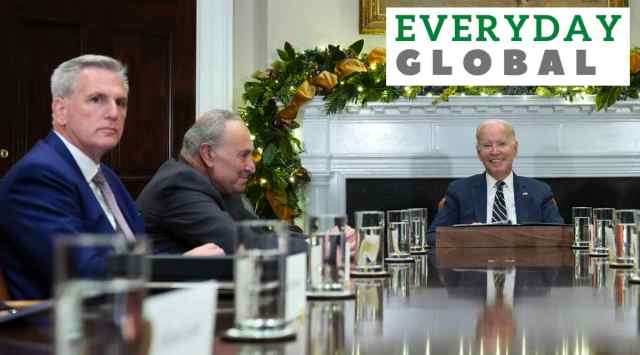Latest Comment
Post Comment
Read Comments
 President Joe Biden, right, at the top of a meeting with congressional leaders to discuss legislative priorities for the rest of the year, Nov. 29, 2022, in the Roosevelt Room of the White House in Washington. (AP Photo/Andrew Harnik, File)
President Joe Biden, right, at the top of a meeting with congressional leaders to discuss legislative priorities for the rest of the year, Nov. 29, 2022, in the Roosevelt Room of the White House in Washington. (AP Photo/Andrew Harnik, File) President Joe Biden will deliver his second State of the Union (SOTU) Address to a Joint Session of Congress at the United States Capitol in Washington DC on Tuesday (February 7) at 9 pm ET (7.30 am in India on Wednesday). The speech will be live streamed by the White House at https://wh.gov/sotu. (Read highlights from Joe Biden’s speech)
The speech will be likely dominated by ideas and themes that the President has long subscribed to — those of working together, asserting US leadership in the world, and giving the American working and middle classes a leg up, The New York Times has reported.
It will be among the biggest speeches of his presidency so far, coming at a time of deep divisions in Congress and the country, and with the US facing complex foreign policy challenges especially with regard to Russia and China.
The President has been working hard on his speech, including on its delivery, The New York Times reported. Biden is the “first modern president to have a stutter, which he has navigated since childhood and still speaks of in emotional terms”, The NYT report said.
What is the annual State of the Union Address, and why is it one of the most important institutions of the US presidency and Congress?
What are the origins of the SOTU tradition?
The formal basis of the Address lies in the US Constitution itself, says a historical note on the website of the House of Representatives, the lower chamber of Congress.
Article II, Section 3, Clause 1 of the Constitution says the President “shall from time to time give to the Congress Information of the State of the Union, and recommend to their Consideration such measures as he shall judge necessary and expedient”.
When was the first SOTU Address given?
The first of these annual addresses was given by the first President George Washington in 1790. However, it was not called SOTU then — for more than a century and a half up to 1946, the Address was formally known as the “Annual Message”.
Already from 1942 though, the message had started to be informally referred to as the “State of the Union” message or address, according to the history of the Address on the House website. And beginning with President Harry S Truman’s message to Congress on January 6, 1947, the address came to be officially known as the State of the Union Address.
Is there a designated venue and date for the Address?
SOTU Addresses in the modern era have been delivered in the chamber of the House of Representatives. A House concurrent resolution decides on the day and time for the Joint Session of Congress to listen to the President.
Up until 1934, the President’s Annual Message was delivered in December; since then, the Annual Message/ SOTU has been delivered in January or February.
Biden’s second SOTU Address on February 7 will be the 99th in-person Address/Annual Message in US history. President Franklin D Roosevelt’s 1945 Address was read to a Joint Session of Congress — since the President did not himself deliver it, it is not counted as an in-person address.
What do Presidents typically say in SOTU Addresses?
Annual Messages by earlier Presidents were more in the nature of Budget speeches — they included agency budget requests and general reports on the health of the US economy.
Subsequently, as Congress required more in-depth reports on these aspects, the Budget Message was instituted by law in 1921 law, and the Economic Report in 1946. These messages were separate from the President’s Annual Message.
The practice of speaking directly to Congress had ceased after a few years into the Annual Message; this was revived after a gap of 113 years by President Woodrow Wilson in 1913. Ever since, the SOTU Address has served as a platform for the President to rally support for his agenda.
How has the Address evolved over time?
The House website flags several key moments in the history of the Address/ SOTU:
* President Calvin Coolidge’s 1923 address was the first to be broadcast on radio, President Truman’s address in 1947 was the first one to be televised, and President George W Bush’s 2002 address was the first to be webcast live.
* The longest written address was delivered by President Jimmy Carter in 1981 (33,667 words); and the longest spoken address was by President Bill Clinton in 1995 (9,190 words).
* The shortest address was the first address, by George Washington in 1790, which was only 1,089 words.
* Through the 19th century, the average Address was about 10,000 words long; from the late 20th century, it has been about 5,000 words.
* President Franklin D Roosevelt gave 12 Messages/ Addresses, the most in US history, 10 of which were in-person addresses.
* Zachary Taylor, the 12th President who served from March 1849 to July 1850, delivered only one address.
* William Henry Harrison, the 9th President who died after serving for only 31 days in March-April 1841, and James A Garfield, the 20th President who was assassinated after serving six months in office from March to September, 1881, did not deliver any addresses.